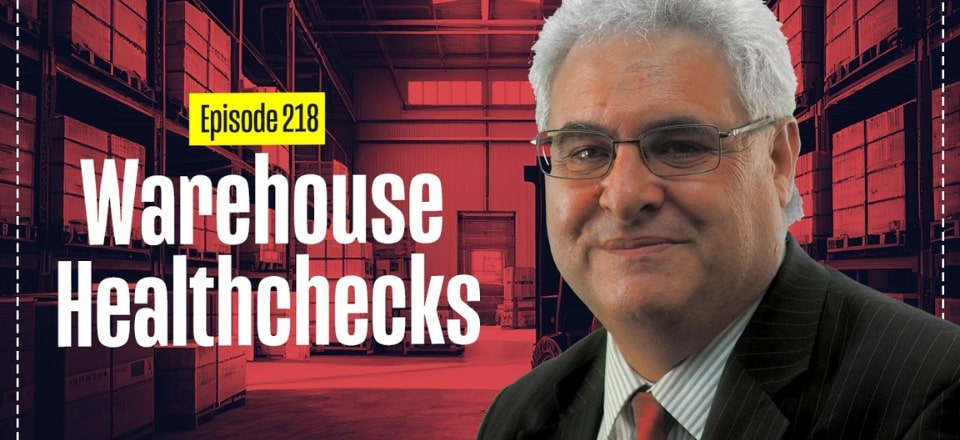Evaluating the health of your warehouse is crucial. You might have overlooked some critical warning signs in your warehouse.
This assessment will help you maximize capacity and streamline processes, ensuring your warehouse runs at peak efficiency.
Check out the video below to discover these indicators and boost your warehouse performance.
Rob: This week they are on the topic of supply chain health checks and more specifically warehousing health checks, and we’ve got one of our warehousing experts from Logistics Bureau here to talk to us today. So let’s get right into it!
So welcome, John, back to the channel, if you watch the channel a few times, you’ll know John Monk, one of our warehousing experts at Logistics Bureau, welcome, John. Great to have you with us.
John: Thank you, Rob!
Common Findings in Warehouse Health Checks
Rob: So we’re talking about health checks. Here at Logistics Bureau, we do a lot of health checks helping people find problems and you do these related particularly to warehousing. Maybe you could tell us some of the things that you find of interest for the clients particularly when you’re doing these warehouse health checks and maybe that will give people have few ideas on what to look for.
John: Yes, Rob, thank you! So some of the things that we often find when we’re looking into a warehouse is the customer tell us that the warehouse is full and sometimes we find that while it might appear full by rearranging things, there’s ore space that can be found. Or they think they’re running quite efficiently, and in fact they’re wasting a lot of time in travel.
Rob: Funnily enough, we were just talking before we started recording this. I was looking at a warehouse in Perth last week. Perth, Western Australia and it was full. So I mean, when you say that people think their warehouse is full, but maybe they can get more capacity. Why do they have this sort of view of the world? Which is maybe not quite right. What are they missing out on?
John: Well, look, I’m not saying they’re not full in terms of their current situation. Usually what they’re referring to as full is every location. Or it’s either you know, occupied or they’ve got product in the aisle so they’ve got congestion. But when you start to look at it, sort of in more detail, what you see is that they might be utilizing the locations but within the location there’s a lot of free space. So maybe by adjusting the location size. We can add more locations and then all of a sudden we might get 20 to 30% more locations. We’re applying very much a lens (2:31) of how we would design a warehouse, and often we’ve got customers that they own the site and they don’t particularly want to move to a new warehouse. The challenge there is, how do we get more space or how do we get more capacity with a better utilisation of the space that they’ve got?
Innovative Solutions for Increasing Capacity
John: In one of our clients, basically we changed it from a standard aisle to an arrow aisle solution and you know with that we got over 30% more capacity within the existing space. So yeah, it all depends I suppose in terms of how well they’re utilising the current space to see how much more we can get.
Rob: I remember that one on the aisle width, so that was interesting. You recommended there that they put articulated forklifts sort of bendy. You’ve never seen one, but it’s like the bendy bus but a forklift.
John: That’s right! I mean, that’s always the challenge is as you start to go narrow aisle, you gotta use different mobile equipment and you know it does range from articulated forklifts, which on side narrow aisle right through the turret trucks which you get to you know very narrow aisle solutions say 1.6 metre type aisle widths.
Rob: So just going back to this warehouse that I was looking at in Perth last week and related to capacity, a lot of people tend to think, oh, we’ll put a mezzanine floor in, you know this one they weren’t utilizing the height of the warehouse for storage, it was all low level shoring, low level shelving. You know at first glance you’d think “Oh, we could put a mezzanine in here and get significantly more capacity”, but what are the pros and cons with that? It probably slows things down a lot. Doesn’t it?
John: Well, certainly you’re got people working at another level and you know that might have environmental aspects as well as obviously they’ve got to, you know, maybe go up some stairs, you know, usually you can have a shoot or some sort of elevator for the product that they’re passing to and from. But yeah, it can be an expensive solution. Alternative solutions you know would be to perhaps rack that area and have equipment where you know the person can go up to shelving at height, a person up for mobile equipment. So yeah, there are a number of different ways of utilizing this space. But often a mezzanine can be relevant if the items are small and you know you’re utilizing shelving, it can be a reasonable solution, but you know there are other ways of getting a lot denser type of product within shelving, even at lower levels.
Related articles on this topic have appeared throughout our website, check them out:
- Warehouse Product Slotting: The Ultimate Guide
- The 7 Principles of Warehouse and Distribution Centre Design
- Planning a Warehouse Network and Design: Key Factors to Consider
- Spotlight on: 7 Key Warehouse Processes
- 10 Proven Principles for Best Warehouse Design and Operation
Editor’s Note: The content of this post was originally published on Logistics Bureau’s website dated December 27, 2023, under the title “Warehouse Health Checks with John Monck“.




